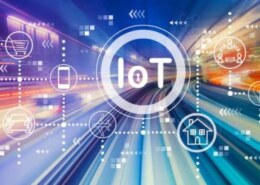The Internet of Things (IoT) refers to the network of interconnected devices embedded with sensors, software, and other technologies that enable them to communicate and exchange data with each other. These smart devices, ranging from household appliances to industrial machinery, are designed to collect, share, and act upon data, creating opportunities for automation, efficiency, and new applications across various sectors like healthcare, agriculture, transportation, and more.
How does IoT work?
The IoT functions through a network of connected devices equipped with sensors that collect data. These devices communicate with each other or a central system using various communication technologies like Wi-Fi, Bluetooth, Zigbee, or cellular networks.
Data collected by these devices are transmitted to a central location or cloud-based platform, where it’s processed, analyzed, and often stored. Users or other systems can access this data remotely to monitor, control, or make informed decisions based on the information gathered from these interconnected devices. This process facilitates automation, improves efficiency, and enables innovative applications in diverse fields.
Why is IoT important?
IoT is crucial for several reasons:
Efficiency: It enhances efficiency by automating processes, optimizing resource utilization, and reducing human intervention in various tasks.
Data Collection and Analysis: IoT devices collect vast amounts of data, enabling businesses and individuals to make data-driven decisions, improve services, and create new products.
Improved Decision Making: The real-time data obtained from IoT devices allows for better and quicker decision-making, leading to improved outcomes in various industries.
Enhanced Convenience: IoT devices often make our lives more convenient by automating routine tasks, controlling devices remotely, and offering personalized experiences.
Cost Savings: Through better resource management and process optimization, IoT can lead to cost savings for businesses and individuals alike.
Innovation: It fosters innovation by providing a foundation for developing new products, services, and business models that were previously not feasible.
What are the benefits of IoT to organizations?
IoT offers numerous benefits to organizations:
Improved Efficiency: IoT enables automation of various processes, streamlining operations, reducing errors, and optimizing resource utilization, leading to increased efficiency.
Data-Driven Insights: The vast amount of data collected by IoT devices provides valuable insights that organizations can use to make informed decisions, enhance services, and innovate.
Cost Savings: Through predictive maintenance, efficient resource management, and process optimization, IoT helps in reducing operational costs and improving the bottom line.
Enhanced Productivity: By automating tasks and providing real-time information, IoT boosts employee productivity, allowing them to focus on more strategic activities.
New Business Opportunities: IoT opens up opportunities for new products, services, and business models, fostering innovation and creating new revenue streams.
Improved Customer Experience: Organizations can use IoT data to personalize offerings, provide better customer service, and create more tailored experiences, thus improving customer satisfaction and loyalty.
Risk Mitigation: IoT facilitates better monitoring and control, enabling organizations to identify risks, prevent potential issues, and respond more effectively to emergencies or disruptions.
What are the pros and cons of IoT?
Pros:
- Efficiency: Automation and optimization of processes lead to increased efficiency.
- Data Collection: Gathering vast amounts of data for analysis and informed decision-making.
- Convenience: Remote monitoring and control of devices for increased convenience.
- Cost Savings: Optimizing resources can lead to cost reductions.
- Innovation: Facilitating new products, services, and business models.
Cons:
- Security Concerns: Increased connectivity can lead to potential security vulnerabilities.
- Privacy Issues: Gathering extensive data raises concerns about user privacy and data misuse.
- Compatibility and Standards: Lack of standardization might lead to interoperability issues among devices.
- Complexity: Managing and integrating numerous devices and systems can be complex.
- Reliability: Reliance on technology could lead to system failures or downtime.
While IoT brings remarkable benefits, addressing its challenges such as security, privacy, and standardization is crucial for its widespread and safe adoption.
Conclusion:
Overall, IoT’s ability to connect devices, collect data, and enable smarter decision-making has immense potential to revolutionize industries, improve quality of life, and drive economic growth.
Embracing IoT technologies can provide organizations with a competitive edge, enabling them to adapt to changing market demands, improve operations, and drive growth.

